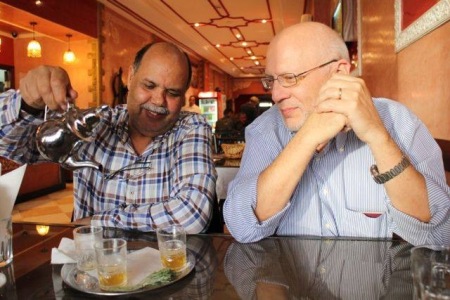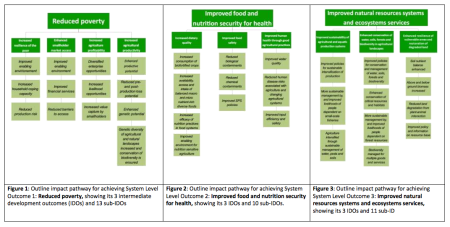Congratulations to our friend and occasional contributor Colin Khoury and to his co-authors on the paper “An Inventory of Crop Wild Relatives of the United States.” The paper has been named “Outstanding Paper on Plant Genetic Resources in 2014″ by the Division C-8 Plant Genetic Resources of the Crop Science Society of America. Richly deserved. The data on which the paper is based can be found on the Crop Wild Relatives and Climate Change webpage.
Action for Nutrition at last, maybe
The Second International Conference on Nutrition (ICN2) drew to a close yesterday, having promulgated the Rome Declaration on Nutrition and endorsed a Framework for Action. From the latter, let us all applaud Recommendation 10 (of sixty):
Promote the diversification of crops including underutilized traditional crops, more production of fruits and vegetables, and appropriate production of animal-source products as needed, applying sustainable food production and natural resource management practices.
FAO is putting its (donors’) money where its mouth is by establishing an Action for Nutrition Trust Fund.
Twice per year the PCU will make a Call for Proposals based on the size of the Fund at the time. The SC will decide which proposals will be funded based on the recommendations from the PCU.
With sixty recommendations to choose from the Programme Coordinating Unit (PCU) will have its work cut out for it.
Have your say on international agricultural research priorities
(The) CGIAR is/are making a big push to elicit input on the new Strategy and Results Framework (SRF). You know the drill: a barrage of surveymonkeys, blogposts, tweets, Facebook posts, targeted emails, webinars, e-consultations, you name it, is coming your way. For all I know they’ll be knocking on doors in carefully selected neighbourhoods around the world. I’m always a little ambivalent when research organizations ask for help in prioritizing their work. On the one hand, it’s always good to ask. On the other, you’d have thought they would know by now.
Anyway, the outcomes of CGIAR’s work are now listed as:
1. Reduced poverty
2. Improved food and nutrition security for health
3. Improved natural resources systems and ecosystems services
And it is good to see the importance of the international genebanks in achieving these system-level outcomes recognized in the section of the SRF describing the particular niche of CGIAR:
The CGIAR community holds in trust globally unique genetic resources for a subset of agriculturally significant species of central importance to sustaining and advancing productivity and yield stability for the world’s smallholders in the 21st century.
Less good, however, to note that use of genetic diversity is thought to only contribute to the reduced poverty outcome, and then only via increased agricultural productivity. Sorry about the poor quality of the image showing this below, click on it to improve it a bit, but it wasn’t that much better in the original document:
There are “cross-cutting topics of global importance — women and youth; climate change; and capacity development — [that] will systematically strengthen and build coherence in research across all domains and Intermediate Development Outcomes (IDOs).” Should not conservation and sustainable use of agricultural biodiversity be one of these? Maybe I’ll respond to one of those tweets from @CGIAR.
What should be the priorities for International Agricultural Research for Development? http://t.co/OPWbKjFciV #ag4dev pic.twitter.com/ftQfg5WOAf
— CGIAR (@CGIAR) November 21, 2014
Moroccan medicinal mint tea

That’s me on the right in Rabat last week, having a post-prandial drink with Dr Ahmed Amri, head of the ICARDA genebank. I post the photo (taken by my colleague Charlotte Lusty) by way of explanation for the lack of blogging lately, and also as an excuse to link to the beta version of Kew’s Medicinal Plant Names Service, which I have just become aware of. You see that bit of greenery on the tea tray? It’s a plant that’s sometimes added to mint tea in Morocco during the winter. It’s called “absinthe” there. If you want to know the Latin name, you can look it up here.
Global Nutrition Report calls for better integration with agriculture sector
The share of nutrition-sensitive investments in agriculture, social protection, water, sanitation and hygiene, education, and women’s empowerment programs needs to expand. The success of these sectors is important for nutrition improvement but they could do much more for nutrition while furthering their own goals. From the available evidence, the authors suggest that nutrition-sensitive expenditures are currently a small percentage of expenditures in these sectors. Partly this is because nutrition allies in the different sectors may not know what to do to make their nutrition programs more nutrition sensitive or why it is in their interests to do so…
That’s from the synopsis of the just-released Global Nutrition Report, the first of its kind. Their point is perhaps illustrated by another just-released report, this one on diabetes. When you finally manage to click through to the bit on prevention, there’s very little on diet, let alone the role of the food system as a whole.
